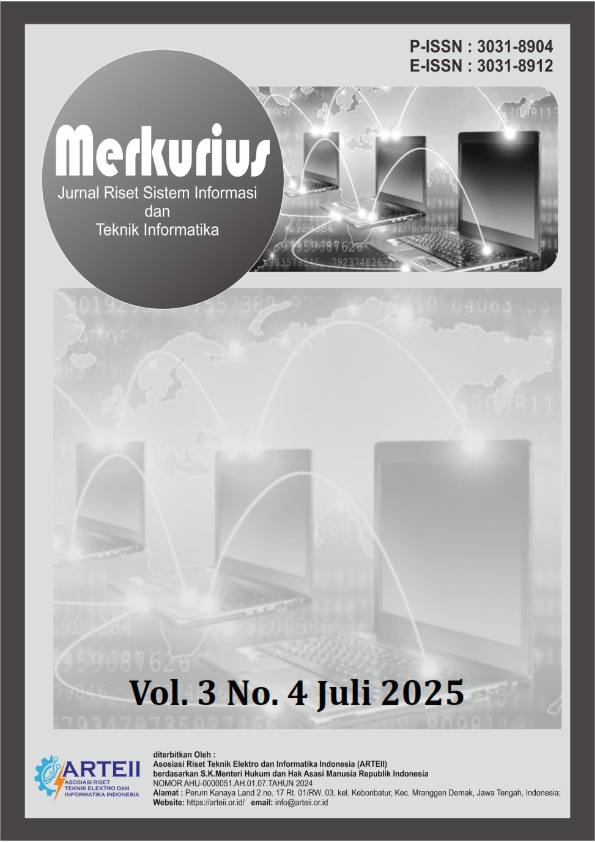Penerapan Dashboard Business Inteligence untuk Bongkar Muat Kapal pada Pelabuhan XYZ Menggunakan Metabase
DOI:
https://doi.org/10.61132/merkurius.v3i4.868Keywords:
Business Intelligence, Dashboard, Port Operations, Resource OptimizationAbstract
The port is a vital infrastructure in the global logistics chain that connects sea and land transportation. The efficiency of cargo loading and unloading operations at the port is a critical factor influencing the smooth flow of goods and overall logistics costs. In this context, the use of Business Intelligence (BI) as an integrated technological system to support data collection, analysis, and presentation is becoming increasingly important for optimizing data-driven decision-making in port environments. XYZ Port, as one of the strategic ports in Indonesia, faces challenges in managing complex loading and unloading operations with increasing cargo volumes. The implementation of a BI dashboard offers a solution to visualize operational data in real-time, identify bottlenecks, and optimize resource allocation. This study aims to implement a BI dashboard for cargo handling operations at XYZ Port. The specific objectives include identifying information needs in cargo handling operations and developing a BI dashboard that suits the characteristics of port operations. The findings indicate that the dashboard effectively supports real-time decision-making and enhances operational efficiency. The study also highlights the importance of addressing technological infrastructure, human resource readiness, and system integration challenges in BI implementation.
References
Carlan, V., Naudts, D., Audenaert, P., Lannoo, B., & Vanelslander, T. (2019). Toward implementing a fully automated truck guidance system at a seaport: Identifying the roles, costs and benefits of logistics stakeholders. Journal of Shipping and Trade, 4(1). https://doi.org/10.1186/s41072-019-0054-5
Duan, L., & Xu, L. D. (2012). Business intelligence for enterprise systems: A survey. IEEE Transactions on Industrial Informatics, 8(3), 679–687. https://doi.org/10.1109/tii.2012.2188804
Gonçalves, C. T., Gonçalves, M. J. A., & Campante, M. I. (2023). Developing integrated performance dashboards visualisations using Power BI as a platform. Information, 14(11), 614. https://doi.org/10.3390/info14110614
Heilig, L., & Voß, S. (2017). Port-Centric information management in smart ports. In Ports and Networks (pp. 236–250). Routledge. https://doi.org/10.4324/9781315601540-15
Hermanto, E. A., Gemintang, S. A., Ariansyah, R., & Giovanny, M. A. (2023). ANALISIS PERBANDINGAN PENERAPAN BUSINESS INTELLIGENCE DI INDONESIA MENGGUNAKAN METODE SYSTEMATIC LITERATURE REVIEW. Djtechno: Jurnal Teknologi Informasi, 4(2), 344–354. https://doi.org/10.46576/djtechno.v4i2.3412
Maulidati, Z., Pangestu, S. B., & Aini, S. N. (2025). Ad-Hoc business intelligence for agile decision-making: A case study using adventure works 2022. INTEGER: Journal of Information Technology, 10(1). https://doi.org/10.31284/j.integer.2024.v10i1.7537
Metabase. (2014). Open source business intelligence, dashboards, and data visualizations. Metabase | Business Intelligence, Dashboards, and Data Visualization. https://www.metabase.com/
Murnawan, Samihardjo, R., & Nugraha, U. (2020). Design of the business intelligence dashboard for sales decision making. International Journal of Psychosocial Rehabilitation, 24(02), 3498–3513. https://doi.org/10.37200/ijpr/v24i2/pr200670
Mz, Y., Bororing, J. E., Rahayu, S., & Ramadhani, T. A. (2022). Aplikasi Dashboard Visualisasi Data Calon Mahasiswa Baru mengunakan Metabase. Edumatic: Jurnal Pendidikan Informatika, 6(1), 116–125. https://doi.org/10.29408/edumatic.v6i1.5483
Olubunmi Awodiji, T. (2021). Interactive dashboard design for manager, data analyst and data scientist perspective. NLP Techniques and Applications, 175–185. https://doi.org/10.5121/csit.2021.111914
Prahendratno, A., Mahendra, G. S., Zebua, R. S. Y., Tahir, R., Sepriano, S., Handika, I. P. S., Rahayu, P. W., Sudipa, I. G. I., & Efitra, E. (2023). BUSINESS INTELEGENT : Pengantar Business Intelligence dalam Bisnis. PT. Sonpedia Publishing Indonesia.
Ritonga, R. A., Ahmadi, N., Kusumastanto, T., Suwandi, R., Suwito, S. R., Hasriningtyas, S., Arafat, H., & Soleh, A. (2022). KESIAPAN IMPLEMENTASI SMART PORT DI INDONESIA. Coastal and Ocean Journal (COJ), 6(1), 8–23. https://doi.org/10.29244/coj.6.1.8-23
Saragih, E. H., Bayupati, I. P. A., & Putri, G. A. A. (2021). Pengembangan Business Intelligence Dashboard untuk Monitoring Aktivitas Pariwisata (Studi Kasus: Dinas Pariwisata Provinsi Bali). Jurnal Teknologi Informasi Dan Ilmu Komputer, 8(6), 1159–1168. https://doi.org/10.25126/jtiik.2021863755
Siti hidayatul Khoirun Nisa’, & Rusdianto, R. Y. (2024). Pemanfaatan Visualisasi Data dalam Meningkatkan Pengambilan Keputusan Bisnis. Jurnal Informasi, Sains Dan Teknologi, 7(2), 200–208. https://doi.org/10.55606/isaintek.v7i2.290
Wibowo, A. S., & Andri, A. (2021). Dashboard business intelligence vusialisasi data akreditasi sekolah pada SMP Negeri 1 sembawa. Jurnal Nasional Ilmu Komputer, 2(4), 249–256. https://doi.org/10.47747/jurnalnik.v2i4.536
Downloads
Published
How to Cite
Issue
Section
License
Copyright (c) 2025 Merkurius : Jurnal Riset Sistem Informasi dan Teknik Informatika

This work is licensed under a Creative Commons Attribution-ShareAlike 4.0 International License.





